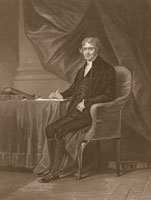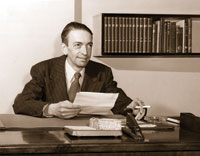
Colonial Williamsburg
Lester Cappon, the first director of Colonial Williamsburg’s Department of Archives and Records.
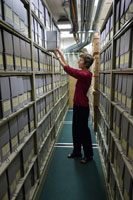
Dave Doody
In the foundation’s archives, Donna Cooke shelves materials in a climate-controlled room.
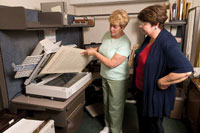
Dave Doody
Patty Walker scans a document to make a digital copy as director of archives Rosanne Butler watches.
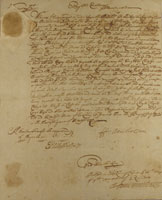
Colonial Williamsburg
All documents, from parchment to paper to virtual ones and zeros, are perishable, but they narrate human history, such as this proclamation by Virginia Governor Frances Nicholson.

Barbara Lombardi
A Williamsburg soldier's Valley Forge letter expresses the private thoughts of one man. Historical documents include the private and the public, and if such items are lost, by negligence or decay, the record is diminished.
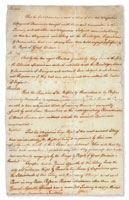
Barbara Lombardi
Patrick Henry’s copy of his Stamp Act Resolves. Whatever its collector’s value, its contents can be duplicated and disseminated.
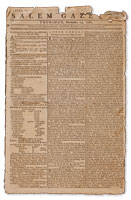
Barbara Lombardi
On microfilm and in other media, such historical documents as this Salem Gazette report on the Battle of Yorktown can be preserved.
No Records, No History
by Christopher Geist
Colonial Williamsburg’s first director of archives and records, a man adept in the practice of history as well as archival theory and management, knew original documents were central to either craft. His name was Lester J. Cappon, and he wrote:
Why does mankind create records and preserve them? The answer is carved in monumental stone: “What is past is prologue.” This sophisticated motto, with its tone of universality, proclaims a perennial purpose, an irrefutable sequence, whether it be in the functioning of government, in the operation of private enterprise, or in the daily life of the person impelled by necessity or desire. Recorded experience, useful in countless ways, indispensable for some purposes of temporary or long-term value, soon becomes historical. The aphorism “No records, no history” is axiomatic, for these are the sources of history—written documents for the most part, but including oral documentation and artifacts of man’s making, past and present.
Visitors to the National Archives in Washington, DC, can see ‘What is past is prologue’ carved on a statue outside the building. Cappon, who tended the Restoration’s files from 1945 to 1952, thought much like an earlier Old Dominion archivist, Thomas Jefferson.
Jefferson? An archivist? Anyone who has delved into Jamestown and early Virginia history would add that title to the others Jefferson earned. Nearly a century and three-quarters after the English landed, he purchased a collection of loose Jamestown records from his cousin Peyton Randolph’s estate, along with the library. The Library of Congress says, “It is a wonder that any originals from Jamestown survived at all.” For nearly five decades, Jefferson preserved and curated the documents he acquired, sharing them carefully and selectively with scholars publishing collections of Virginia’s statutes. The Library of Congress now tends them, the richest collection of Jamestown records in the country.
The Jamestown papers Jefferson rescued were incomplete and fragmented. Some early items burned in fires at the Virginia colony’s first capital. Some may have been lost during conflicts with Native Americans. Others crumbled for lack of care. Politics had been a threat, too.
Jamestown was a creature of the Virginia Company of London, a joint-stock enterprise James I chartered in 1606. The failing business broke into factions led by Sir Thomas Smythe, its first chief executive, and Sir Edwin Sandys, who ousted Smythe to become its second. Sandys accused Smythe of concealing records of Smythe’s administration to cover up mismanagement, and launched investigations. With the king’s support, Sir Edwin led his majesty’s opponents in the House of Commons—Smythe maneuvered to discredit Sandys and regain control, making cover-up allegations of his own. Sandys protected himself and evidence of how he conducted the Virginia business by duplicationg minutes of its meetings, or courts, and other records. As the Reverend Mr. William Stith of Williamsburg wrote in his 1747 Virginia history, Sandys had the documents privately “copied and compared, and authentically attested . . . in Vindication of his own and the Company’s Reputation.”
James’s government dissolved the bankrupt Virginia Company in 1624, making the colony his and royal. The “Original Court-Books were taken from the Company by the King and Privy Council, and never again restored to them . . . probably destroyed or lost.”
Sandys’s copies, two bound court books, came into the hands of Virginia’s William Byrd in England, and later were conveyed to Randolph’s father, John, who contemplated writing a Virginia history, too, a project not completed. The records were in deplorable condition when Jefferson obtained them. January 16, 1796, he wrote to Williamsburg’s George Wythe that the manuscripts “will not bear removal” from Monticello, their “being so rotten, that in turning over a leaf it sometimes falls into powder.” To save the relics, Jefferson decided on “wrapping and sewing them up in oiled cloth, so that neither air nor moisture can have access to them.” Jefferson’s devices retarded deterioration and destruction until the Library of Congress’s twentieth-century preservation practices stabilized the fragile sheets.
State Librarian H. R. McIlwaine published his Minutes of the Council and General Court of Colonial Virginia in 1924, noting in the introduction the importance of Jefferson’s work. Jefferson’s preservation of the Jamestown records was all the more important because “the great mass of the records of the General Court of Virginia . . . was destroyed in the burning of the State court building” as the Confederates evacuated Richmond on April 4, 1865.
Jefferson knew just how fragile were his state’s documentary records. “Very early in the course of my researches into the laws of Virginia,” he wrote, “I observed that many of them were already lost.” He determined to “collect all that were then existing.” It was an enormous task, one in which he said he “spared neither time, trouble, nor expense.” Jefferson realized the almost transient condition of the records, and the folly of attempting to maintain a single copy of any document indefinitely. “All the care I can take of them,” he wrote, “will not preserve them from the worm, from the natural decay of the paper, from the accidents of fire.”
To his list he might have added floods, hurricanes, and tornadoes, as well as deliberate destruction by individuals suppressing information, dispersal to parts unknown by careless or dishonest officials, and sometimes the ravages of war. There were as well records “in the hands of careful or curious individuals, on whose death they would probably be used for waste paper.”
Jefferson’s solution? “The lost cannot be recovered; but let us save what remains: not by vaults and locks which fence them from the public eye and use, but by a multiplication of copies, as shall place them beyond the reach of accident.” The printing press made his plan feasible, and at least twice he offered encouragement and access to his document collection to compilers publishing early records. Ebenezer Hazard used them in Historical Collections, a 1792–94 assemblage of records from British North America and the early history of the United States. In 1823, William Hening drew on Jefferson’s collection for his Statutes at Large, Being a Collection of All the Laws of Virginia.
Jefferson’s strategy of reliance on multiple copies is still in use, but what would he make of archival science in the twenty-first century? Surely, a man of his talent and intellectual curiosity would revel in touring a modern archival facility, but the volume of the materials now accessioned and the never-ending, daunting task of organizing and maintaining the collections would almost certainly overwhelm him. Although the task he set himself was large, when Jefferson sought to gather up all Virginia laws “then existing,” it was realistic for an individual to contemplate such an undertaking. Many a modern archive numbers its items in the tens or hundreds of thousands or more, with Information Age potential for collections to grow exponentially.
Nowadays, collecting, preserving, and maintaining everything in a given archival category likely are impossible. That makes it important to gauge just what must be saved and for what purpose. Each archive’s collections policy is central to addressing the problem. Dana Nemeth, director of Ohio’s Wood County Historical Center, relies on selective collecting based on her institution’s mission and collection development policies to keep from being overrun. Nemeth knows that “what is saved determines what will be told in the future,” and this often dictates collaboration with other institutions. “What can we collect and take care of and be good stewards of the records?” is a concern because so many archives are underfunded. Sharing materials and information spreads financial and human resources and maximizes scholarly and public access to archival information.
Ann Bowers, archivist of the National Student Affairs Archives, raises another issue: “Does a document fit our collecting scope, and is it the best document for our collection and the best format?” More and more records preserved in archives do not exist solely, or at all, in paper format. Digital documents ranging from early computer tapes, to floppy discs, to hard drives and more contain information desired by historians and others. And what of Twitter and Facebook posts by prominent individuals? Email messages, websites, and blogs proliferate. How are originals distinguished from copies? And just what constitutes an “original document” in the digital age?
North Dakota’s state archivist, Ann B. Jenks, says digital records are the greatest challenge facing her and her colleagues in the twenty-first century. Problems working with digital materials begin with “their preservation over the long term, the ability to access the records you want, making sure they have not been altered from the original, and figuring out how to pay for the continuous back up and migration of data as software and hardware change.” Nemeth is also concerned about maintaining “old and outdated equipment to read older document formats”—necessary but straining tight budgets.
Archivists and scholars have faced some of these issues before. Using Sandys’s Jamestown documents in their attested copies format offers scholars uncertainties. Have the documents been copied exactly? Is punctuation, capitalization, order, and emphasis preserved as in the original. What may have been added for political or other reasons? Are there careless or intentional omissions? The only difference today is the volume of records in myriad formats with which modern archivists must deal.
Archivists are in general agreement that, though it is important to conserve and preserve original documents, it is the information they contain that is of most value to historians. Jenks says, "Archivists are supposed to guess what might be useful to someone fifty or more years from now and on into the future. We are basing that on what is important to people now, so, at best, it is just a good guess.” Often documents are microfilmed and, increasingly, scanned into computer formats. “Surrogate records are fine,” Nemeth says; “it’s the information that is important, not the tangible original. . . . Archives are not museums— we share information, not necessarily the original artifact.” Others find surrogate records less than satisfactory. Bowers says, “Scanning can’t take the place of original documents,” but it can be necessary for the sake of storage space and preservation.
In addition to such threats as the ravages of time, there are such hazards as inks that fade quickly and others that rot paper. Exposure to sunlight damages or erases images. Some paper rapidly deteriorates. Magnetic fields destroy formats of electronic and digital documents. Adhesives and containers earlier archivists used sometimes damaged items. Scanning and microfilming are desirable when the issue is preservation of fragile or lone copies of primary documents. They make possible storage of documentary records in multiple sites, answering Jefferson’s advice to “multiply and disperse copies” of historic records.
Jenks says that in North Dakota, “sometimes diaries and letters were microfilmed because of their fragile condition so that people could access the information without having to handle the item. Now these items would more likely be scanned to provide more access.
“In some cases we have filmed the proceedings of a county commission as a backup in the event the courthouse is damaged by flood, fire, tornado, etc. . . . We store the microfilm master in a vault and duplicates are located elsewhere.” And for ultimate security, local and federal government agencies have access to abandoned underground mines in Kansas, Pennsylvania, and Kentucky to store microfilm masters. Multiplication of copies, indeed.
A subcommittee of the United States Senate Committee on Homeland Security and Governmental Affairs convened a hearing May 14, 2008, titled “National Archives Oversight: Protecting Our Nation’s History for Future Generations.” Senator Thomas R. Carper, chairman, opened with a reference to Jefferson’s reverence for history education. That protecting and preserving that history are related to homeland security is telling. Yet as the hearing progressed, the senators got a heavy dose of archival reality. Preserving the collective past is no easier in the digital age than it was when Jefferson scoured Virginia in search of fugitive statutes to add to his assemblage.
James S. Henderson, representing the Society of American Archivists, testified that digitization of documents “is a long-term royal pain and expense. . . . Electronic records are not, as everybody is saying, like the nice paper you put on the shelf that is going to last 400 years. It won’t.” In an appendix to the hearings’ record, United States Archivist Allen Weinstein said that the federal government was swamping the National Archives and gobbling its resources with an explosion of electronic records, including “text documents, e-mails, web pages, digital images, videotapes, maps, spreadsheets, presentations, databases, satellite images, geographic information systems, and more.” Sounding almost Jeffersonian, Weinstein said, “Unlike parchment or paper, electronic records can become inaccessible quite quickly” as hardware and software become obsolete “within years or months.” Nevertheless, Weinstein offered hope. “Technology for preserving electronic records,” he said, “is finally catching up with the technology for creating them.”
Christopher Geist, professor emeritus at Ohio’s Bowling Green State University, contributed the story “Virginia’s Daughters” to the spring 2013 journal.

